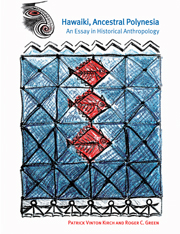Book contents
- Frontmatter
- Contents
- List of figures
- List of tables
- Preface
- List of language abbreviations
- Prologue: on historical anthropology
- Part I The phylogenetic model: theory and method
- 1 The phylogenetic model in historical anthropology
- 2 Methodologies: implementing the phylogenetic model
- 3 Polynesia as a phylogenetic unit
- Part II Rediscovering Hawaiki
- Epilogue: on history, phylogeny, and evolution
- Notes
- Glossary of terms
- References
- Subject Index
- Index of Proto Polynesian Reconstructions
1 - The phylogenetic model in historical anthropology
Published online by Cambridge University Press: 06 January 2010
- Frontmatter
- Contents
- List of figures
- List of tables
- Preface
- List of language abbreviations
- Prologue: on historical anthropology
- Part I The phylogenetic model: theory and method
- 1 The phylogenetic model in historical anthropology
- 2 Methodologies: implementing the phylogenetic model
- 3 Polynesia as a phylogenetic unit
- Part II Rediscovering Hawaiki
- Epilogue: on history, phylogeny, and evolution
- Notes
- Glossary of terms
- References
- Subject Index
- Index of Proto Polynesian Reconstructions
Summary
Physical type and language, we would say, have no causal relationship; there is no functional reason why a given physical type should occur within a given language family. Therefore, when these two variables do show significant concordance in their distribution this may well represent an important historical fact, namely that the explanation for their concordance can be traced to a common point somewhere in the past. A demonstration that these two factors are also uniquely accompanied by a systemic culture pattern … strengthens the belief in a common origin.
romney 1957:36The “phylogenetic model” has a long pedigree within historical anthropology, traceable in its essentials to Sapir's 1916 monograph. In the 1950s, it was formally developed under the label of “the genetic model,” a term that might be confused with a strictly biological perspective of somatic (genetic) inheritance, and which we (Kirch and Green 1987) therefore replaced with “phylogenetic model.” This revised label emphasizes historical sequences of cultural differentiation or divergence within related groups, regardless of the mechanism of transmission. Indeed, in the complexities of human history, both somatic and extra-somatic modes of trans-generational inheritance are salient (Durham 1982, 1991; Boyd and Richerson 1985). Thus a phylogenetic model within historical anthropology must incorporate data and perspectives from the full range of anthropological subdisciplines, including biological anthropology, archaeology, historical linguistics, and comparative ethnology.
In this introductory chapter we will sketch the intellectual history of the phylogenetic model within anthropology, including its applications in Polynesia; discuss some current issues surrounding its applicability; compare its principal methods with phylogenetic (cladistic) approaches in biology and linguistics; and, finally, argue the fundamental signifance of a phylogenetic understanding of homologous change within historical anthropology.
- Type
- Chapter
- Information
- Hawaiki, Ancestral PolynesiaAn Essay in Historical Anthropology, pp. 13 - 31Publisher: Cambridge University PressPrint publication year: 2001



